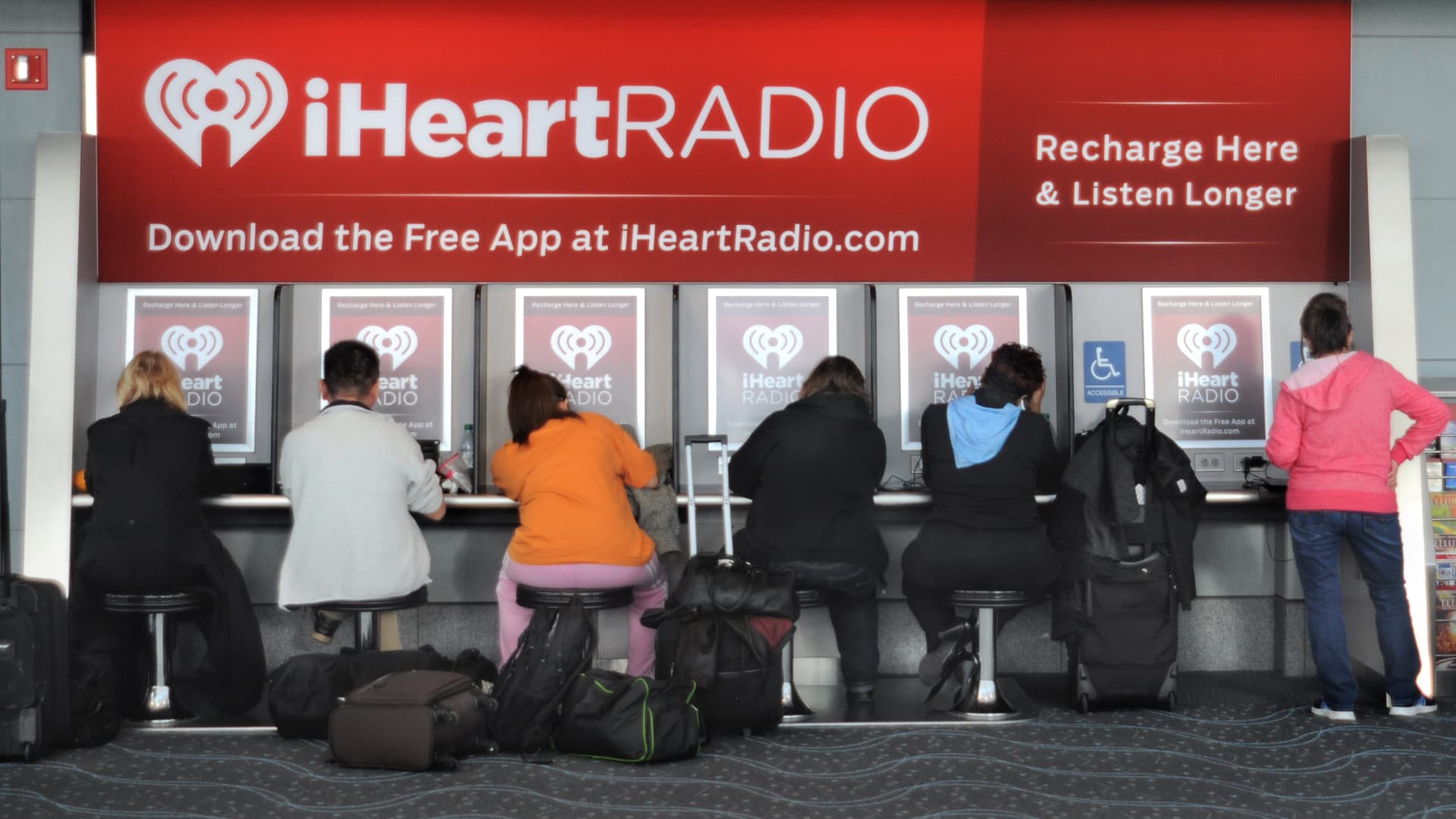Airline passengers between flights patronize the iHeartRadio facility at Denver International Airport in Denver on Jan. 19, 2014.
Robert Alexander | Archive Photos | Getty Images
It’s a familiar refrain: “Legacy media is dead” — unless you’re talking about radio.
Despite being one of the oldest media formats, dating back to the 1890s, radio has maintained relatively stable listenership over the past decade. Pay TV, while newer, has faced more significant declines.
In 2009, 92% of Americans age 12 or older listened to traditional, or terrestrial, radio in a given week, according to data from Pew Research published last year. By 2022, that number fell 10 percentage points. Pay TV penetration, on the other hand, fell 20 percentage points between 2014 and 2023, according to data firm Statista. In the third quarter of last year, the pay TV industry shrank at a record pace, analysts at MoffettNathanson said in their latest cord-cutting report.
“Terrestrial radio has stayed steady even as other mediums like satellite radio, podcasts and Apple CarPlay have come on board,” said Guggenheim media analyst Curry Baker.
“Historically, radio personalities and stations have engaged with local audiences,” which tend be “sticky,” Baker said. “Cable networks never really did that.”
Radio has maintained the upper hand on many media formats partly because of its accessibility and relative lack of cost barriers. Most cars come already equipped with access to AM and FM radio at no additional cost, and according to Statista data from 2022, the majority of U.S. drivers choose to listen to terrestrial AM/FM radio over any other form of entertainment on the road.
But radio listenership has also been bolstered by the unique ability of stations to capture local audience loyalty. Listeners tune in to hear familiar voices, such as Elvis Duran on New York’s Z100 or Ryan Seacrest on Los Angeles’ KIIS-FM. Conservative commentators have also traditionally commanded large followings on their radio shows, such as Fox News’ Sean Hannity.
Contests and sweepstakes represent another unique draw to terrestrial radio. Major stations are known to allow listeners to call in and win prizes such as tickets to concerts or cash.
“Radio is an interactive medium, and part of that is contesting,” Tom Poleman, chief programming officer at iHeartMedia, told CNBC. “For over half of our listeners, contesting is one of the reasons that they come to radio. Over time, contests has become more accessible with digital options like text-to-win and social media contests. Radio is also inherently social: 80% of our listeners say that they come because they trust our host to be the voices of the community.”
iHeartMedia, which controls 860 stations across the U.S., captures an average of 250 million monthly listeners, the company said in November, the largest reach of any radio broadcaster in the U.S.
Over-the-air evolution
Like other legacy media, radio has faced increasing encroachment from digital audio formats, such as podcasting and streaming platforms. Radio giants such as iHeartMedia and SiriusXM have adopted podcasts and digital output as part of their business models.
Podcasts, in many respects, function as the streaming iteration of radio, in the same way that Netflix was the streaming iteration of cable.
Top radio companies have positioned themselves to benefit from the podcasting boom, in stark contrast to some media companies’ contentious relationship with streaming, as many have struggled to migrate their declining cable revenue to streaming.
“There’s something about being able to focus on a human voice that is compelling,” Poleman said. “Our radio hosts have naturally become great podcasters and we weren’t surprised to see the explosion in podcasting. We feel it’s very complimentary toward broadcast radio.”
Still, just like TV, radio faces advertising headwinds as the industry looks to recover from the Covid-19 pandemic slump, said Guggenheim’s Baker.
In November, iHeartMedia CEO Bob Pittman noted ongoing “uncertainty” in the advertising industry. Multiplatform revenue was down 5.1% for the company year over year in the third quarter of 2023, primarily caused by a “decrease in broadcast advertising due to a challenging macroeconomic environment and a decline in political advertising,” the company said in a press release.
Guggenheim forecasts iHeartMedia’s broadcast advertising revenue to decline about 23% for the full year 2023 when compared with 2019 levels.
Likewise, other media companies have reported declining ad revenues within their TV units in recent months. CNN owner Warner Bros. Discovery reported a 12% drop in ad revenue for its TV segment for the third quarter of last year. Global TV ad revenue for 2023 is expected to be down 18% year over year, according to media investment firm GroupM.
Baker also forecasts a “flat to down” broadcast revenue outlook for iHeartMedia and the terrestrial radio industry as a whole. But in the face of pay TV’s rapid decline, radio is faring well amid the broad contractions in the media industry.
A spokesperson for the iHeartMedia noted that listening habits have changed since 2019 as more customers make the switch to listening on a digital platform, contributing to the decline in advertising revenue from broadcast.
The representative also pointed towards the company’s growth in total revenue when compared to 2019, which factors in advertising revenue from both digital and broadcast platforms. For the third quarter of 2023, iHeartMedia brought in $953 million in revenue, they said, while in 2019’s third quarter, the company captured $948.3 million in revenue.
“For [radio broadcasters], the hope is you can stabilize the terrestrial business enough and continue to grow the digital business to where digital growth offsets terrestrial secular pressures,” Baker said. “If you model this out, the digital business simply overtakes the legacy terrestrial business in the next five to six years.”
Don’t miss these stories from CNBC PRO:






